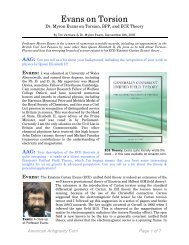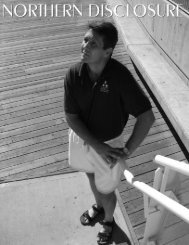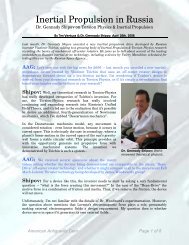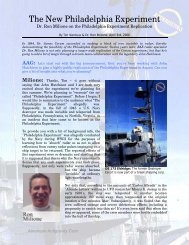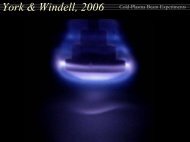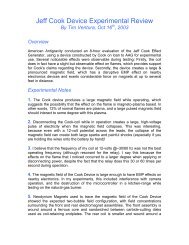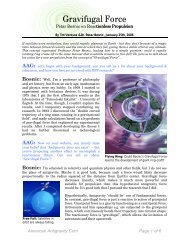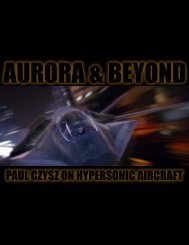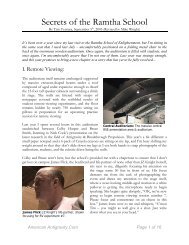Podkletnov-Interview.. - American Antigravity
Podkletnov-Interview.. - American Antigravity
Podkletnov-Interview.. - American Antigravity
You also want an ePaper? Increase the reach of your titles
YUMPU automatically turns print PDFs into web optimized ePapers that Google loves.
AAG: One of the things that I was wondering about is whether you’ve been able to doefficiency calculations for the force-beam.<strong>Podkletnov</strong>: Well, Dr. Giovanni Modanese made some preliminary measurements thatgave us the force in joules, but we did not try to make predictions – we wanted to simply see theresults of how different objects reacted to the action of this impulse, so we didn’t make anyprecise calculations.AAG: The type-II YBCO emitter measured 47mm in diameter, if I remember correctly. Doeschanging the size or the shape change the beam output – maybe making it stronger orrefocusing it?<strong>Podkletnov</strong>: Well, in terms of the size ofthe superconducting emitter, there are somelimitations. The diameter of the superconductorshouldn’t be smaller than 4 inches, because of theSchwartzchild radius. Now to answer yourquestion, in terms of the shape of the emitter, thesuperconductor can in fact have different shapes,and the projected impulse will maintain theemitter’s cross-sectional shape, so is important.AAG: The 4-inch minimum size for thesuperconductor seems to limit the public’s ability toperform experimental replications. The largestcommercial available superconductor that I’ve seenis a 1” superconductor – so it sounds like theemitters require custom fabrication?<strong>Podkletnov</strong>: Well the size is very important– we didn’t get any good results with smallersuperconductors, and it’s also more difficult tocreate the correct flat-glow discharge with smallersuperconductors.AAG: Have you noticed any changes in themolecular structure, internal materialsdeformation, or maybe simple mechanicalcompression in the targets that you’d sent the beamthrough? You’d mentioned metals deforming andholes through concrete…<strong>Podkletnov</strong>: We didn’t see anycompression effects or any change of the molecularstructure – just a large scale deformation of thetarget material from the beam’s force.AAG: I should ask whether the beam losesenergy as it penetrates materials. Does it naturallydecrease or diverge with distance?Emitter Configuration: Schematic of twosuperconducting emitter apparatus designs.<strong>American</strong> <strong>Antigravity</strong>.Com Page 3 of 13
<strong>Podkletnov</strong>: That’s an interesting question…and to our great surprise the beampractically does not lose energy when it meets the materials. It can pass through a brick wall orconcrete, or metal-plates – very thick ones – or plastics also, and it seems that it doesn’t loseenergy at all. This is the consistent, long-term evidence from a lot of test discharges weperformed at an installation I’ve been working at for about 4 years.These results seem a bit strange, but we don’t believe we’re breaking any natural laws…simplythat the system we’re working in is not a closed one, and therefore the second law ofthermodynamics is not applicable in the traditional sense.In terms of action at a distance – and the dependence of distance on the beam energy – we don’thave much experimental data, but what we do have is a first measurement at a distance of 1.2kilometers without any loss in energy. Our latest experiment was conducted over a distance of 5kilometers, and the beam penetrated through several houses made of concrete. We did notmeasure any loss of energy, but after closely evaluating some of the calculations that we’vemade, we should get some decrease in beam-energy at distances greater than 100 kilometers.This is research that awaits us in the future.AAG: You’d mentioned 5 kilometers –did you notice any change in the focus of thebeam. Did it widen or perhaps get smalleras it travels?<strong>Podkletnov</strong>: If the main solenoidwhich is wound around the chamber ismade in a good way, then we have a verygood discharge and it effectively maintainsa non-divergent cross-sectional pattern ofthe emitter it was projected from. However,at a distance of 5 kilometers, the beambegins to lose focus– it gets a bit wider thanit was, indicating minor deviations in theshape of the impulse as it propagates.AAG: I collected a few questions online,and one person wrote me, “Is it possible togenerate more work along the path of thebeam than energy put into the beam?” Ithink they were asking about potential“over-unity” applications.<strong>Podkletnov</strong>: It’s been surprising tofind that the energy that we put into thedischarge is much less than the energy thatthe impulse seems to generate, but itdoesn’t mean that it’s an over-unity device,simply that we’re creating a set of specialspace-time conditions through theinteractions of the electromagnetic pulsedischargewith the bose-einstein condensate(superconductor). By manipulating theseDischarge Chamber: A complete layout-schematicof the chamber showing experimental components.<strong>American</strong> <strong>Antigravity</strong>.Com Page 4 of 13
“politically correct” scientific establishment towards gravity-modification is negative, whichcreates a lot of difficulties.However, I don’t hide anything, and when peoplecontact me directly or by email I usually try to giveall the advice that I have and to share myexperience with them. The problem is toocomplicated for one country or for one lab tosucceed; gravity should be studied all over theworld using the best forces and the brains ofdifference scientists. That’s the key to success.AAG: I think we’ve already agreed that one ofthe chief obstacles to a successful replication is the4-inch superconductor – do you know if those aremanufactured and sold anywhere, or is that aprocess that everyone has to go through to buildtheir own?Dr. Modanese: <strong>Podkletnov</strong>’s researchpartner, physicist, and force-beam co-author.<strong>Podkletnov</strong>: Frankly speaking, in the case of extremely effective emitters that’s a part ofmy professional know-how, but if you’re only talking about emitters that allow you to generatesmall effects, then it’s not a problem. I believe that <strong>American</strong> Superconductor can help to easilymake emitters of this kind, and also there is a nice firm called “Superconductive Components” inColumbus, Ohio – they’re more or less familiar with my technology, and I think that they are upto the task of building emitter components.AAG: So essentially, by using a smaller superconductor you have a smaller effect, but thatcan be tested by using more sensitive equipment.<strong>Podkletnov</strong>: The diameter of the disk should still not be less than 4-inches, but I’mtalking about the physical structure of the ceramic itself. The structure for efficient emitters isvery difficult to build, and requires a lot of experience to build correctly, so even if I provided adetailed description, it would be difficult to construct without my help. Normal emitters whichallow you to push a thick book away from a table are possible to construct, as they aren’t quite socomplicated.AAG: I had a question from another person whowas asking about video, but they were also askingabout a flat-glow discharge.Dr. Ning Li: A colleague of <strong>Podkletnov</strong>’s andspecialist in gravitomagnetic coupling effects.<strong>Podkletnov</strong>: Well, in order to make a videofor the flat-glow discharge, we should use a highspeedvideo camera that we don’t presently have, sowe typically have to rely on our keen sight, but it’s abit difficult. We’re planning to film it, but even witha normal discharge – a spark, as in a van de graafgenerator, or in a flat-glow discharge, which repeatsthe configuration of the emitter, it’s possible to seeit with your own eyes -- you don’t need a camera forthat.<strong>American</strong> <strong>Antigravity</strong>.Com Page 7 of 13
AAG: Now in terms of experimental setup, because I’m getting ready to buy parts…it lookslike, from reading through your experimental setup, that essentially you’re discharging a highvoltageonto a superconductor – that, and the superconductor itself is inside a magnetic field. Itlooks in some ways deceptively simplistic, but I understand that there is a definite challengeinvolved with it. Have you found any real tricks to testing with this?<strong>Podkletnov</strong>: Well, this technology is really nothing special, but I work with a team ofexperienced people who are experts in high-voltage discharges, experts in ceramic materials &superconductors, and experts in magnetic fields, and only by combining the knowledge differentfields and people from different countries can we reach something positive. This internationalcollaboration becomes inevitable, and becomes the key to success.Emitter Experimental Setup: An overview of the emitters subjected to a high-voltage discharge.AAG: Dr. Bob Baker is working on putting together a 2006 High-Frequency Gravity-WaveConference as a follow-up to the earlier one in 2003. Has he contacted you about this, andwould you be open to attending?<strong>Podkletnov</strong>: No, he hasn’t sent me anything. You know, I have a job here and I don’twant to risk it, especially without firm opportunities for funding. I’m hoping to find investorswise enough to see how much money this research can generate. Unfortunately, up to now theydon’t understanding it – if I release this technology, if they put money in it – then we willdefinitely succeed in it, and in 2 or 3 years they will be richer than Bill Gates, but thisunderstanding comes very slowly. We’ve been hoping for commercial funding, because theimpulse generator is basically a gravity-gun, and I’m not really interested in providing a weaponof strategic importance to the United States. If we’re talking about new propulsion systems,though, I’m eager to share my knowledge. Of course the gravity-beam can also used forpropulsion, but the rotating superconductor can be used only for creating propulsion – a verticalcolumn to help lift a craft off the surface of the earth.AAG: The force-beam that you’d mentioned coming out of the back of the impulse generatorhad a negative effect on living organisms, right?<strong>American</strong> <strong>Antigravity</strong>.Com Page 8 of 13
<strong>Podkletnov</strong>: Yes, it produced a strange kind of non-focused radiation that was veryharmful to biological tissue -- fortunately for us; the impulses were very short in time. It wasvery harmful to living organisms; we also observed a melting or molecular-juxtaposition effect ofbiological tissues with plastic materials, and even with metals to some extent.AAG: So this was a very different force than the impulse coming out of the front of thegenerator?<strong>Podkletnov</strong>: Yes, it was an entirelydifferent force, and it was not focused like thegravity-beam.AAG: In “The Hunt for Zero Point”, Nick Cookdescribed an experiment in the 1940’s called the“Nazi-Bell” that reportedly exhibited side-effectslike the crystallization of cell-membranes in plantsand the breakdown of living tissue into a greasysubstance after repeated exposure. Does thissound similar in any way to what you sawemanating from the back of the impulsegenerator?Deflection: Deflection of pendulum duringtesting as a function of discharge voltage.<strong>Podkletnov</strong>: Well, I can’t speak for what they might have seen – during the 40’s I hadn’teven been born yet! However, it might be that the side-effects are similar to ours. There areseveral effects that are similar to this – one is the Hutchison Effect, where he reported moleculardistortions & materials juxtapositions, which is similar to the anecdotal claims of “sailorsmelting into decks” in the Philadelphia Experiment legend.AAG: Oh, so you’re actually talking about a radically different set of associated effects…didyou witness anything like atomic transmutations or Low-Energy Nuclear Reaction (LENR)effects occurring, or just the molecular-level anomalies?<strong>Podkletnov</strong>: Well, the radiation that emanates from the rear of the impulse-generatormight somehow create conditions suitable to LENR effects, but this wasn’t an area of focus inour research, so I really don’t know. Our primary focus was on studying the gravity-beam itself.AAG: In terms of the force-beam, you’ve said that it was hundreds of pounds of force, and Irealize that it was very difficult to measure. You’ve said that it was also enhanced with 5-millionvolt discharges. Can you tell me a bit more about this?<strong>Podkletnov</strong>: Yes, it output force depends on the voltage and also on the effect of howsharp the the impulse is. If the rise-time of the impulse is long in duration, then we have alower-power impulse, and if it is very sharp – I mean the voltage rises very fast – then the effectis very large and is able to bend metal plates.AAG: Ok, did you test on anything besides metal or concrete, to try some other substances?<strong>American</strong> <strong>Antigravity</strong>.Com Page 9 of 13
<strong>Podkletnov</strong>: It’s not a drilling-machine, sorry. We’re interested mainly in the use of thistechnology for propulsion in space, and frankly speaking it really is what you’d call“propellantless propulsion”.AAG: Let’s focus on that for a second: when you noticed the impulse force on objects in thebeam path, was there an equal & opposite force on the superconductor itself?<strong>Podkletnov</strong>: No, there wasn’t. There was no reaction force at all.AAG: So if you put the superconductor inside ofa spacecraft then, I guess that it wouldn’t produce aconventional forward propulsion?<strong>Podkletnov</strong>: Yes, it doesn’t act according toNewtons third law – that every force has an equalan opposite reaction. But simply thesuperconducting emitter, whether it is a rotatingdisk or the discharge-system, is able to create agravitational wave in what you might call the aetheror the space of subatomic particles. Or you call it agravity-wave. So this wave propagates throughspace, through all the objects, sometimes it caninteract with normal matter, but to my surprise itdoes not lose its energy at very high distances – itremains collimated as it propagates.Amplitude: Relative pulse-amplitude fromimpulse-discharge experimental testing.AAG: Did you notice any other strange effects in the general area? Anything in addition tothe impulse itself, the effect on objects, or the strange radiation coming out behind?<strong>Podkletnov</strong>: No, we didn’t, but frankly speaking it is not very easy to measure all theseadditional effects. You know, when you’re dealing with millions of volts, it’s better to keep a bitof safe distance. We use a faraday cage and special rubber-metal coatings to shield the radiation,because otherwise the high magnetic field strength from the discharge will erase computer harddrives and damage nearby test-equipment.AAG: When you analyzed the metal samplethat was bent with the gravity-beam, did it appearto be only bent forward in the direction of beampropogation? Dr. Bob Baker postulates thatgravity-waves may be quadripolar in nature, andI’m wondering if these waves might leave adetectable signature in the materials they deformto help validate his theory…<strong>Podkletnov</strong>: In our experiments we wereable to observe only the forward action.Deflection: Angle of pendulum deflectioncorrelated with adjusted pulse amplitude.AAG: Do you think that there might be anytorsion physics involved with the impulsegenerator?<strong>American</strong> <strong>Antigravity</strong>.Com Page 10 of 13
<strong>Podkletnov</strong>: I think that torsion or axial fields may be present in our experiments, butit’s more suitable to suggest a role for torsion physics in our original rotating disk experiments -the mechanism behind the impulse-generator is a bit different.AAG: Speaking of which, in terms of the failed NASA replication for the rotating-diskexperiment, I’d heard from a NASA insider that they only spun it up to about 200rpm. Does thatmean that they didn’t fully complete your experiment?<strong>Podkletnov</strong>: I cringe every time I hear that NASA failed to replicate my experiment,because no, they didn’t fail. They made their own disks, and they were big enough: about 12inches in diameter. They published some initial test information indicating that they haddefinitely noticed some unusual effects. Then I got involved in participating to helping them toreplicate my experiments, and they practically had everything ready when they ran out ofmoney. So at the last stage they were not able torotate the superconductor in the magnetic field,and shortly after that the department of defensecame in and grabbed all the experiments. All of thisresearch was transferred to Dr. Ning Li – so nowNASA has nothing, and we have nothing either.AAG: So is Dr. Ning Li still in charge of theproject then?<strong>Podkletnov</strong>: I think so, but the point is thatNASA never completed the experiment, and thusnobody can claim that they failed to see results,because they never completed it.AAG: Have you ever been approached by theDepartment of Defense for any kind of funding?<strong>Podkletnov</strong>: No, they would not do it. I ama citizen of Russia so they wouldn’t even try.AAG: Well, the Chinese, though, have a gravitylab:have they expressed any interest in yourresearch?Rotating Disk: A cutaway of the Type-IIdisk apparatus from the first experiment.<strong>Podkletnov</strong>: They expressed real interest and they’ve invited me to China several times,but they are like kindergarteners: they want me to come just and give them completedtechnologies. They have a rather good theoretical school but they haven’t achieved much inpractice, and they seem rather limited in funding, so I am not eager to travel to China and workthere at my own expense.AAG: Have you ever been able to gravity-research lab in China? Bob Baker visited a coupleof years ago, and was impressed by their efforts.<strong>American</strong> <strong>Antigravity</strong>.Com Page 11 of 13
<strong>Podkletnov</strong>: No, but I’m perfectly aware of the projects they have and their progress indevelopment, because I have very good relationships and discussions with my colleagues fromdifferent countries, although I haven’t seen it with my own eyes.AAG: One of the responses that we had online was the question, “with nearly a decade ofexperience, why haven’t we been able to see videos or photos of your experiments up until now?”<strong>Podkletnov</strong>: Well first of all, when we began those experiments, in Tampere in the early90’s, it just wasn’t common practice to make videos or photos of the equipment or of theexperiment. I know that it’s typical in the United States, but here in Europe it’s different…andthe same thing goes for Russia, especially with the last experiment in the Moscow ChemicalResearch Center, because the whole center is a very secure facility and some of the researchlaboratories are closed to the general public. In our case, nothing was secret, but it was adangerous environment because we use high-voltages, so it’s a closed lab. We have special signson the walls of the laboratory which do not allow us to make any photos. It’s an accepted,established policy at this scientific research center, and I didn’t want to break the rules.AAG: Well, in light of the publicity that you’ve had recently, have you given thought to doingany photos or video in the near future?<strong>Podkletnov</strong>: I’ve discussed this possibility with the administration and they think itmight be possible, but at present wedon’t have any photos or video to sharewith you.AAG: OK – well, I look forward tohopefully seeing some in the future if itturns out that it’s possible. To movealong, have you been able to obtainfunding from government or privateinterests? Has there been a fair amountof interest that’s come forward and triedto provide funding for yourexperiments?Project Delta-G: The now-defunct NASA grouptasked with examing superconductive gravity-coupling.<strong>Podkletnov</strong>: There has been some interest from the private sector, because by policy thegovernment does all of the research into gravity and experimental gravity. This type of researchis not popular, so we don’t get much money from the government. Of course, we use the rightinstallations at the technological center. There is some interest in general all over the world –like the United States and Great Britain, but we didn’t get any funding from the government. Weget rather small funding from the private sector, but our plans are really amazing and we needconsiderable fundin g. So this topic of gravity is a bit unusual, and we need some exoticmaterials…we need special installations, we need cryogenic systems, we need the help of toppeople who are qualified in their own areas, and these all cost a lot.AAG: Just to wrap things up, because we’re almost out of time, again it sounds like you’regetting amazing results – you’re able to put holes through concrete and bend metals with this at5 million volts – these are remarkable results. Is there anything you’d like to say in close?<strong>American</strong> <strong>Antigravity</strong>.Com Page 12 of 13
<strong>Podkletnov</strong>: I don’t think thatthese results are remarkable in general.This subject called experimental gravityresearch has a very big potential, and ifwe compare how complicated thisproblem is to the problem of, let’s say,nuclear explosives, I think that gravityresearch is much more complicated. Buteven if we speak about nuclear power,there was a period in the United Stateswhen everybody was interested, and themilitary and people wanted to makesome research, and the government wasinterested. Then people came and said,“could you please make a smallexplosion, and then we will give youmoney for a big one?”…but it’sGravity-Wave: The core of a gravity-wave event aspredicted by Dr. Robert Baker’s HFGW research.impossible to make a small nuclear explosion. The same thing refers to gravity – it’s anenormous problem, and we can’t get much if we don’t have an organized approach as it was inthe nuclear program for example in the United States. Only combining the knowledge ofdifferent fields, and of different physicists, chemists, and materials scientists & theoreticalphysicists – only through them working together can we make a breakthrough in this field,because it’s very, very serious research.Dr. Evgeny is a research scientist living in Finland, with an impressive body of experimentalresearch relating to EM/gravitational coupling in superconductive materials. His publishedabstracts about the impulse generator experiment are online at: Investigation of HV dischargesthrough large ceramic superconducting electrodes, Superconductor Impulse Gravity Generator<strong>American</strong> <strong>Antigravity</strong>.Com Page 13 of 13



